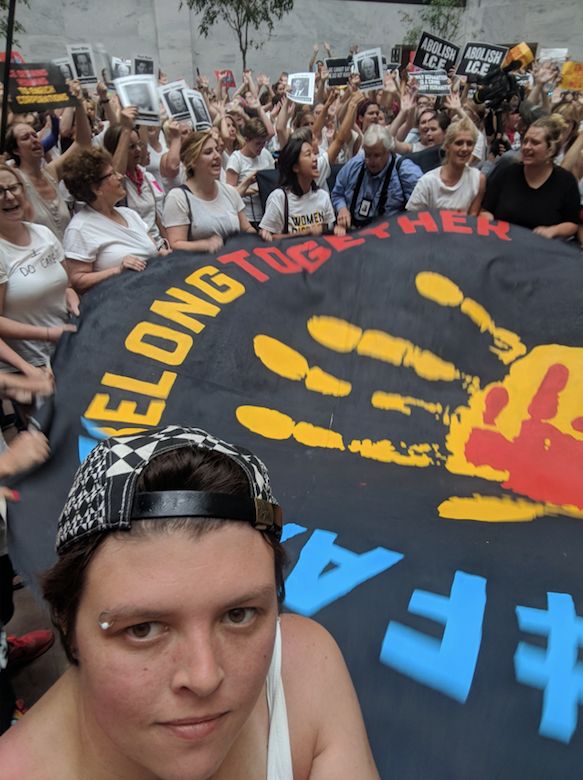
Two weeks ago, I was one of more than 600 mostly white protesters arrested during the #WomenDisobey demonstration at the Hart Senate Office Building in downtown Washington, D.C. All of us were there for the same reason: to take a stand against the brutal immigration policies of President Donald Trump. I engaged in the demonstration knowing I would risk arrest, and with the expectation that I would be subject to much of the same discomfort that everyone experiences when arrested.
I had never been arrested before. However, as an attorney who has interviewed criminal clients and filed civil rights complaints involving the circumstances surrounding arrests in the past, I had a pretty good idea of what to expect.
I would be patted down. My belongings would be searched, catalogued and held until I was released. Hopefully I would get them back, but there was no guarantee. I would be put in handcuffs and transported to a jail or other holding facility for at least a few hours.
If I was lucky, the arresting officer would treat me gently. If I was unlucky, the officer might be very rough with me. I would not be permitted to keep my prescription medications with me. If I was fed during my stay, any food allergies or sensitivities would likely be ignored. Nothing about my situation would be comfortable. Nothing would be within my control.
That is why I was so surprised by what actually happened. As I sat, arms linked with a group of angry women, shouting my demands that Immigration and Customs Enforcement be abolished and calling the police racists, a single officer approached me. He gave me the option of going along voluntarily with the arrest. I was not handcuffed, nor were most of the women arrested that day.
Instead, the officer confiscated my ID so he would know for whom he should issue the warrant if I tried to run. Then a single officer politely escorted us in groups of 25 to a lawn across the street. As long as we stayed in the groups under the supervision of the arresting officer, we were allowed to sit and talk in the shade for roughly two hours while they processed our paperwork before releasing us.
“The officers brought us fresh bottled water, and helped us track down handbags misplaced in the chaos.”
I lay on the ground under a giant shade tree, resting my feet. None of my belongings were searched. I was able to keep my water bottle, medications and food supply in my possession. The officers even brought us fresh bottled water, and helped us track down handbags misplaced in the chaos. Several women were doing yoga on the lawn or taking group photos while the officers smiled and chatted with us.
Don’t get me wrong. I am thrilled that the officers were so kind and professional. I am glad I didn’t spend a night in jail, and that I was allowed to keep my gluten-free protein bars and my medications. But as I lay there under that tree, all I could think about was how many people of color have very different interactions with police.
Any time a police officer injures or kills a person of color, some people are quick to jump to the officer’s defense. They start pointing out every mistake the person of color has made, as evidence that the officer was right to fear them. However, that ignores the fact that the officer probably has no knowledge of the person’s background or prior arrests.
It ignores people like Anthony Wall, who was choked by a police officer before being arrested for arguing with a Waffle House employee. It ignores studies like the Marijuana Arrest Research Project, which shows that 85 percent of people arrested for marijuana possession in New York between 2014 and 2016 were people of color. It ignores the sizable body of research showing that people of color are stopped, arrested and killed by police officers at higher rates than their white counterparts.
The idea that people of color are to blame for the manner in which they are treated by police also ignores the well-documented accounts of blameless people of color who are killed by officers. Philando Castile, who was killed by officers for carrying a legal firearm during a routine traffic stop. Stephon Clark, a father of two shot eight times by officers while walking through his own neighborhood. Rekia Boyd, whose arresting officer was acquitted for his role in her death — not because he was innocent, but because the judge argued that the officer couldn’t be charged with reckless behavior. Claudia Gomez, a young woman from Guatemala with a degree in forensic accounting, who was shot by an ICE agent for no reason as she tried to cross the border. Were they all to blame for their own deaths?
In fact, a study published in the Journal of Epidemiology and Community Health indicates that people of color killed by police die younger and at disproportionately higher rates than the white population in this country.
It is time we take a long, hard look at arrests in America. It is time we start asking ourselves why there is such a disparity in the way arrests are handled depending on skin color. Why do officers stop people of color at disproportionately higher rates than they do white people? Why do they assume they are entitled to behave violently toward a black man during an arrest but treat at least some white women with deference and respect?
“Why do police assume they are entitled to behave violently toward a black man during an arrest but treat at least some white women with deference and respect?”
The entire immigration policy that brought me to the Hart Senate Office Building is a testament to the fact that our government believes people of color cannot be trusted. Families fleeing horrifying violence are being indefinitely detained in cages for allegedly committing a “crime” equal in severity to my own. I was released after only two hours. Those immigrants are still sitting in detention facilities.
The brutality with which police treat people of color is nothing new, but the age of technology has brought heightened awareness to the issue. For the first time in this country, white people are finally beginning to see what experience taught people of color long ago ― that many police officers are less trusting and more violent toward people of color than toward their white-skinned counterparts.
The manner in which the Trump administration handles race relations appears to have emboldened those who harbor racist sentiment. These days, it seems as though hardly a day goes by that we don’t hear about a Barbecue Becky, a Permit Patty or an ID Adam: white-skinned individuals who call the police on people of color over nonexistent or minor infractions.
I’m not sure where we go from here. I’m still shocked at how seamlessly my arrest played out. It was one thing to know my privilege. It’s another thing entirely to have experienced it firsthand.
As a lawyer who wants to believe in our justice system, I understand and recognize that police officers have to take steps to protect themselves. I understand there are times when it may be appropriate to handcuff, search, and/or detain an individual who is a threat to himself or others. What I do not understand is why 600 angry, mostly white women are trusted implicitly while people of color subjected to arrest are regularly restrained and battered before being searched and jailed for even the most minor infractions. It is time for this country to take a good, hard look at how we are conducting arrests and why the policies of arrest shift depending on the skin color of the person involved.
Have a compelling first-person story you want to share? Send your story description to pitch@huffpost.com.
